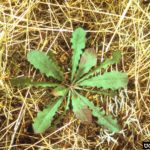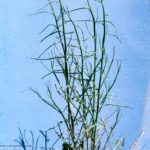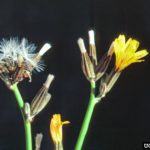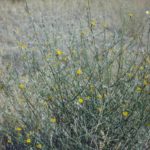Gallery:
- Rush skeleton weed rosette
- Rush skeleton weed
- Rush skeleton weed flower
- Rush skeleton weed in flower
Common names:
Rush skeleton weed, skeletonweed, naked weed, gum succory
Scientific Name:
Chondrilla juncea
Description:
Rush skeleton weed is a deep-rooted perennial plant in the Asteraceae (sunflower) family. It has dandelion-like rosettes and a taproot that can grow 7 feet deep. The leaves on the stem are few and very narrow and bract-like. When the plant flowers, the rosette leaves die, leaving behind just stems, which make it look skeleton-like. The yellow flowerheads are 1/2 inch wide and they grow in the leaf axils and stem tips. One of the most distinguishing features are stiff the downward pointing hairs on the lower portion of the stems. It spreads through root fragments and root buds, but also through its seeds that have white bristles that allow them to be carried by the wind, similar to the dandelion.
Life cycle:
Perennial (Biennial in its native range)
Height of mature plants
Typically 1 to 4 feet tall, but can grow to 5 feet tall
Flower color:
yellow
Bloom time:
July – September
Look-a-likes:
Rush skeleton weed is a bit similar to dandelions and other dandelion-like plants.It has dandelion-like rosettes and a similar milky latex sap in the stems. The flower heads on rush skeleton weed have fewer “petals” than the dandelion (The “petals” are technically individual flowers. Rush skeleton weed only has 7 – 15, compared to a dandelion which has more than 70). Also. Rush skeleton weed has more branches and occasional narrow leaves on the stems.
Habitat:
Rush skeleton weeds prefers well-drained, disturbed, sandy, or rocky soils. It invades crop and grain fields, rangelands, pastures and roadsides.
Impacts:
Rush skeleton weed is a very aggressive plant, especially in rangelands and grain fields of eastern Oregon. It is banned in 9 western states. The long taproot allows it to draw water from deep under the surface, making it both drought resistant and competitive with other plants. It displaces native or desirable plants, and also has very little leaf surface, making control with herbicides very difficult. Hand pulling can be effective, but difficult because the plant can grow back from root buds, so control must be repeated for 6 to 10 years until the root reserves are depleted. One plant can produce up to 20,000 seeds.
Noxious Weed Listing:
- WeedWise: priority
- State of Oregon: Class B, T
- State of Washington: Class B
- Four County CWMA: Class D
- Columbia Gorge CWMA: Class B
Origin:
Northern Africa, Asia and Europe
Links:
Oregon Noxious Weed Profile
Washington Noxious Weed Control Board Profile
CABI Invasive Species Profile
NRCS Plant Guide




